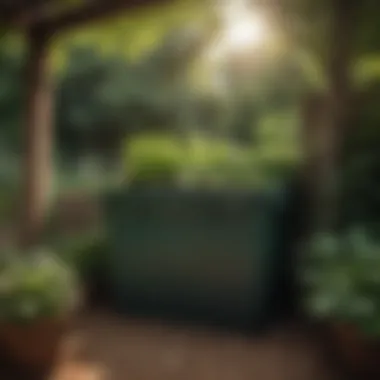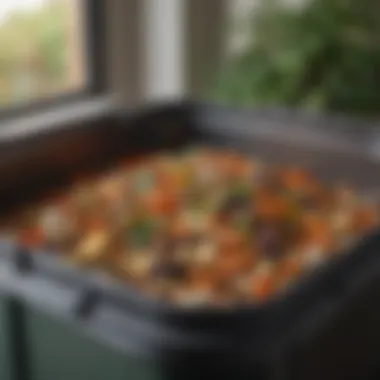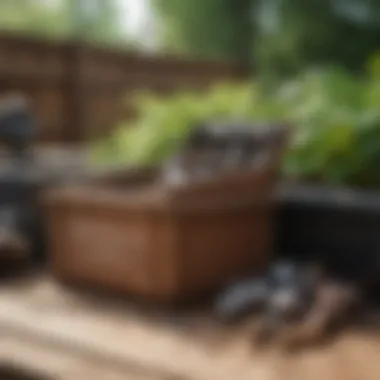The Comprehensive Guide to Selecting and Using a Home Composting Bin


Overview of the Topic
Composting is a crucial practice in sustainable waste management, contributing significantly to reducing organic waste in landfills and promoting soil health. The process of composting involves decomposition of organic materials such as food scraps, yard waste, and paper into nutrient-rich compost that can be used to enrich soil for gardening and farming purposes. By understanding the key benefits of composting and selecting the right composting bin, individuals can actively participate in environmental conservation and minimize their carbon footprint.
Current Status and Challenges
The current state of organic waste disposal poses a significant challenge to environmental sustainability, with landfills overflowing and emitting harmful greenhouse gases. Inadequate waste management practices contribute to soil degradation, water pollution, and overall environmental degradation. Challenges such as lack of awareness, accessibility to composting facilities, and misconceptions about composting techniques hinder widespread adoption of composting as a viable waste management solution.
Sustainable Solutions
Embracing composting as a sustainable solution to organic waste management presents numerous environmental and social benefits. By diverting organic waste from landfills, composting reduces methane emissions, conserves landfill space, and produces a valuable soil amendment. Various sustainable practices, including vermiculture, hot composting, and bokashi composting, offer efficient ways to decompose organic matter and produce nutrient-dense compost for agricultural and gardening purposes. Successful case studies worldwide showcase the effectiveness of community composting initiatives and municipal composting programs in promoting sustainable waste management practices.
Impact and Importance
The impact of composting on ecosystems, communities, and future generations underscores the significance of integrating composting into daily waste management routines. Composting enriches soil fertility, improves plant growth, and reduces dependency on chemical fertilizers, contributing to agricultural sustainability. Conservation efforts focused on promoting composting not only mitigate environmental impacts of organic waste but also foster a culture of environmental stewardship and resource conservation for a greener tomorrow.
Introduction
In this informative article, we will delve into the nuances of selecting and utilizing a composting bin for home purposes. Composting is a practice that offers a plethora of environmental advantages while simultaneously providing practical benefits for households. By understanding the intricacies of composting, individuals can actively contribute to sustainable living and reduce their ecological footprint.
Understanding Composting
Benefits of Composting
Composting offers a sustainable solution for managing organic waste by converting it into nutrient-rich soil. This process not only minimizes landfill buildup but also enriches soil health, fostering robust plant growth and biodiversity. Embracing composting as a regular practice can significantly reduce reliance on chemical fertilizers, promoting eco-conscious gardening practices.
Environmental Impact
Composting plays a pivotal role in environmental conservation by reducing methane emissions generated from decomposing organic matter in landfills. By diverting kitchen scraps and yard waste from trash bins to compost bins, individuals can mitigate greenhouse gas emissions and support a healthier planet. The environmental benefits of composting extend far beyond waste reduction, contributing positively to climate change mitigation efforts.
Types of Compostable Materials
Various materials can be composted, including kitchen scraps, yard trimmings, and organic matter like leaves and shredded paper. These materials are categorized into 'green' (nitrogen-rich) and 'brown' (carbon-rich) components, aiming to achieve a balanced carbon-to-nitrogen ratio essential for successful composting. Understanding the diverse range of compostable materials empowers individuals to create nutrient-dense compost for gardening and soil enrichment purposes.


Why Compost at Home?
Reduction of Organic Waste
Composting at home actively contributes to diverting organic waste from landfills, where it would otherwise release harmful greenhouse gases during decomposition. By converting kitchen and garden waste into compost, households can play a significant role in waste reduction and resource optimization. This reduction in organic waste also reduces the strain on municipal waste management systems, promoting a more sustainable approach to waste disposal.
Production of Nutrient-Rich Soil Amendment
One of the primary benefits of composting at home is the production of nutrient-rich soil amendments that enhance soil structure and fertility. Compost acts as a natural fertilizer, enriching the soil with essential nutrients that promote plant growth and vitality. By integrating homemade compost into gardening practices, individuals can cultivate healthier plants, reduce reliance on synthetic fertilizers, and foster sustainable agricultural methods.
Promotion of Sustainable Practices
Composting at home fosters a culture of sustainability by encouraging individuals to actively engage in eco-friendly practices. This hands-on approach to managing organic waste highlights the interconnectedness of waste reduction, soil health, and environmental well-being. By promoting sustainable practices like composting, households can cultivate a greener future, where every action contributes to a more resilient and eco-conscious society.
Choosing the Right Composting Bin
Choosing the right composting bin is a crucial step in creating an effective and sustainable composting system at home. In this section, we will delve into the key factors to consider when selecting a composting bin that aligns with your needs and goals. By understanding the importance of choosing the right bin, you can optimize the composting process and maximize the benefits for your household and the environment.
Factors to Consider
Available Space
When deciding on a composting bin, the available space plays a vital role in determining the size and type of bin that will fit your environment. The size of your outdoor or indoor space will influence whether you opt for a compact bin that can be placed in a small area or a larger bin that requires more room. Consider the dimensions of the space where the bin will be located to ensure easy accessibility for maintenance and proper aeration.
Composting Goals
Understanding your composting goals is essential when selecting a bin that aligns with your objectives. Whether you aim to reduce kitchen waste, enrich soil for gardening, or minimize your carbon footprint, your composting goals will dictate the type of materials to compost and the capacity required from the bin. Having clear objectives will guide you in choosing a bin that meets your sustainability targets.
Budget Constraints
Budget considerations are significant in the selection process of a composting bin. Various types of bins come with different price points, ranging from budget-friendly options to more advanced systems with higher costs. Assessing your budget constraints will help determine whether you prioritize affordability or invest in a durable bin with additional features. By understanding your financial limits, you can make an informed decision that suits both your needs and wallet.
Types of Composting Bins
Tumblers


Tumblers offer a convenient way to compost organic materials by rotating the bin to aerate and mix the compost. Their key characteristic lies in their ease of use and efficiency in producing compost quickly. Tumblers are a popular choice for individuals seeking a low-maintenance composting solution that accelerates the decomposition process. However, their disadvantage may lie in limited capacity compared to other types of bins.
Wire Bins
Wire bins provide a simple and cost-effective option for composting, offering ample aeration for decomposition. Their key characteristic is the excellent airflow they provide, promoting the breakdown of organic matter efficiently. Wire bins are favored for their affordability and ability to be customized in size and shape. Nevertheless, their disadvantage may involve the escape of smaller compost materials through the wire mesh.
Vermicomposting Bins
Vermicomposting bins utilize worms to break down organic waste, producing nutrient-rich compost known as vermicompost. The key characteristic of vermicomposting bins is the involvement of worms in the decomposition process, resulting in high-quality compost beneficial for soil health. Vermicomposting bins are popular for their compact size, making them suitable for indoor use and producing compost steadily. However, monitoring moisture levels and ensuring proper worm habitat conditions are essential considerations for successful vermicomposting.
Setting Up Your Composting System
Setting up your composting system is a crucial step in promoting sustainable practices in your household. It involves creating an environment where organic waste can decompose efficiently, turning into nutrient-rich soil for future use. By carefully selecting the location, understanding layering techniques, and managing the system effectively, you can contribute significantly to reducing waste and supporting healthier ecosystems.
Location and Placement
Indoor vs. Outdoor
When considering the location for your composting bin, you must decide between indoor and outdoor setups. Indoor composting is a viable option for those with limited outdoor space or living in apartments. It offers convenience and odor control since the composting process is contained indoors. Conversely, outdoor composting allows for larger bins, increased capacity, and natural aeration. It may require more effort in monitoring moisture levels and pest control but is ideal for those with sufficient yard space.
Sunlight and Drainage Requirements
Sunlight and drainage are crucial factors in composting success. A balance of sunlight exposure is essential to aid in the decomposition process without drying out the materials or causing overheating. Adequate drainage ensures that excess moisture can escape, preventing odors and promoting airflow. Choosing a location with the right amount of sunlight and implementing proper drainage systems will create an optimal environment for composting.
Accessibility for Regular Maintenance
Ensuring easy access for regular maintenance tasks such as turning the compost pile, adding materials, and monitoring moisture levels is key to a successful composting system. Accessibility simplifies the maintenance process, encouraging consistent care and proper aeration. Consider placing your compost bin in a location that is easily reachable to facilitate regular maintenance and optimize composting efficiency.
Layering Techniques
Balancing Green and Brown Materials
Achieving the right balance between green (nitrogen-rich) and brown (carbon-rich) materials is essential for efficient decomposition. Balancing these materials promotes microbial activity, speeds up the composting process, and prevents odors. Green materials include kitchen scraps and fresh plant trimmings, while brown materials consist of leaves, straw, and paper products. Understanding the ratio and layering technique will lead to well-structured compost and nutrient-rich soil.
Maintaining Proper Moisture Levels


Proper moisture levels are critical for a healthy compost pile. Maintaining a damp, but not sopping wet environment encourages microbial activity and decomposition. Regularly monitoring moisture content and adjusting by adding water or dry materials is necessary to prevent the pile from becoming too dry or compacted. Consistent moisture levels facilitate the breakdown of organic matter, ensuring efficient composting.
Turning and Aerating the Compost
Turning and aerating the compost pile are essential tasks to introduce oxygen, manage moisture, and promote decomposition. Turning the pile weekly or bi-weekly prevents compaction and allows for even decomposition. Aerating through mixing or adding bulking agents improves airflow and microbial activity. These actions enhance compost quality and accelerate the overall composting process, resulting in rich, healthy soil for your plants.
Managing and Maintaining Your Composting Bin
In the intricate process of household composting, the aspect of managing and maintaining your composting bin is of paramount importance. Ensuring the effective functioning of your composting system is crucial for its success and sustainability. By addressing key maintenance tasks such as monitoring moisture levels, balancing green and brown materials, and regular turning and aerating of the compost pile, you contribute to the efficient breakdown of organic matter into nutrient-rich soil amendment. This section aims to delve into the essential practices that promote the longevity and productivity of your composting bin, guiding you through troubleshooting common issues that may arise.
Troubleshooting Common Issues
Odor Control
Odor control is a critical aspect of maintaining a healthy composting environment. By effectively managing odors, you not only enhance the usability of your compost but also prevent potential nuisances. Implementing proper aeration, ensuring the correct balance of carbon and nitrogen-rich materials, and avoiding compacted layers are key characteristics of odor control. This proactive measure reduces the likelihood of putrid smells emanating from your composting bin, fostering a more pleasant composting experience overall.
Pest Prevention
Mitigating pest infestations is vital to the smooth operation of your composting system. Pest prevention strategies such as covering food scraps adequately, securing compost bin lids tightly, and avoiding the addition of meat and dairy products are imperative. The unique feature of pest prevention lies in its ability to safeguard your compost from insects and rodents without the need for harmful chemicals. While pests can disrupt the composting process, effective prevention measures maintain the integrity of your compost pile, ensuring its efficacy in producing nutrient-rich soil amendment.
Compost Maturity
Monitoring the maturity of your compost is essential for determining its readiness for use in gardens and planters. Compost maturity signifies the completion of the decomposition process, indicating that the organic matter has transformed into a stable, nutrient-rich soil amendment. The key characteristic of compost maturity is its dark, crumbly texture and earthy smell, reflecting its suitability for enhancing soil quality. Understanding the unique feature of compost maturity enables you to harness the full potential of your compost, maximizing its benefits in supporting plant growth and sustainability.
Conclusion
In the vast realm of sustainable practices, embracing composting at home marks a crucial step towards reducing our environmental footprint. The significance of composting goes beyond mere waste management; it symbolizes a commitment to nurturing the planet. By diverting organic matter from landfills and allowing it to decompose naturally, we not only minimize methane emissions but also enrich the soil with vital nutrients. This virtuous cycle of waste reduction and soil revitalization forms the cornerstone of a more eco-conscious lifestyle, echoing the ethos of responsible consumption and resource preservation.
Embracing Eco-Friendly Habits
Contributing to Waste Reduction
Composting stands as a beacon of waste reduction, channeling discarded organic materials back into the earth's regenerative cycle. This process of converting kitchen scraps and yard trimmings into nutrient-rich compost embodies a proactive stance against the mounting threat of landfill overflow. The appeal lies in its simplicity - a fundamental act with profound implications for sustainable living. As we engage in composting, we actively participate in the transformation of waste into a valuable resource, aligning our actions with the harmony of nature.
Supporting Healthy Ecosystems
At the heart of composting lies a profound commitment to supporting healthy ecosystems. By nourishing the soil with homemade compost, we foster biodiversity and enhance soil structure, paving the way for thriving plant life. The interplay between decomposers, microbes, and organic matter catalyzes a dynamic ecosystem wherein each component plays a vital role. This synergy not only benefits our immediate surroundings but also ripples outwards, promoting ecological resilience on a broader scale.
Fostering a Greener Future
The act of composting transcends individual actions, culminating in a collective vision of a greener future. By instilling eco-conscious habits today, we sow the seeds for a more sustainable tomorrow. Composting embodies the ethos of responsible stewardship, urging us to tread lightly on the planet and prioritize preservation over exploitation. As we embrace this greener path, we inspire others to follow suit, sparking a ripple effect of positive change that resonates far beyond our immediate sphere of influence.



